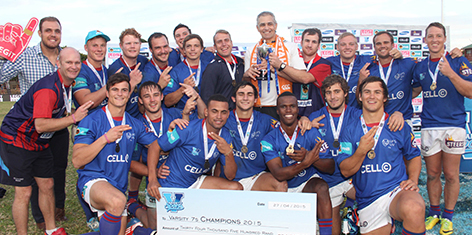
The Sevens team of the University of the Free State followed in the footsteps of the Shimlas when the team was crowned national champion. The Kovsies Sevens team beat Tukkies April in the final of the Varsity Sevens tournament. Photo: Supplied.
The University of the Free State (UFS) Rugby Club has succeeded once again in creating a culture of values.
Marius van Rensburg, Chairman of the UFS Rugby Club, believes this was one of the reasons why Kovsies had so many rugby successes this year.
The UFS knows that money, which is more abundant at bigger universities, won't change the club into a rugby force, but "there is something special here," he said.
Van Rensburg added that the success of Shimlas, who won the Varsity Cup for the first time, also helped to build a winning culture.
Seven finals
Seven of the UFS Rugby Club's teams played in finals during 2015.
Shimlas beat the Pukke in the Varsity Cup final at Shimla Park on the Bloemfontein Campus.
The Kovsie Young Guns (against Tukkies) and Vishuis (Mopanie from Tukkies) got stuck in Bloemfontein in Varsity Cup finals.
The Shimlas won Section B of the USSA tournament in Johannesburg (against Madibaz in the final).
A strong Irawa rugby team beat Shimlas in the City Cup.
The Kovsie Sevens team was crowned as the Varsity Champions in Cape Town after beating Tukkies in the final. The team was beaten by Maties in the final of the USSA Sevens tournament in George.
Shimlas lays foundation
According to Van Rensburg, the Varsity Cup triumph by Shimlas laid a good foundation.
“After what happened in the Varsity Cup, the winning culture kind of washed over the other teams,” he said.
He also thinks the 2015 successes didn't happen overnight, but that the club managed to bring back good values. He feels that Franco Smith, the former Shimlas coach who is the Cheetahs’ current coach, also played an important part.
Greater pressure in 2016
In 2016, the UFS's rugby teams will have a greater target on their backs.
Van Rensburg agrees that there will be greater pressure, but the structures are in place.
He feels that Varsity Cup success goes together with a touch of luck, of which Shimlas had some this year.
“Looking at the draw, Shimlas will play their first two matches away against Ikeys and Tukkies. Therefore, after two matches, one might have no league points, and that would place the team under immediate pressure.”